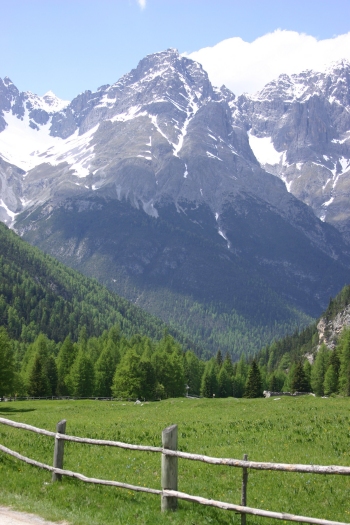Greg & Penny's Swiss Holiday
Day Five Sunday 6 June 2010 Very little is open on a Sunday so this was another driving day. It seems we had run out of easily manageable loops so we decided to head northeast from St Moritz up the valley toward Scuol. From there we hoped to find a route somewhat off the beaten track to enjoy another picnic and eventually settled on S-charl, on the edge of the National Park. The drive to Scuol was somewhat less interesting, being, as it was, on a main road with traffic all the way. Having said that we did pass some intriguing activities on the way; as we passed one village we could see a cricket match taking place, all the players immaculately dressed in their cricket “whites” and, as we passed another village, a church/village fete was in full swing with accordion music and a range of games and activities. (It was still going strong when we came past on our return journey about seven hours later – must have been a good day).
After lunch we visited the local museum and although the descriptions of the exhibition were all in German, Italian and/or French (no English) we managed to make sense of it reasonably well. It turns out that the area was rich with iron-ore and salt and, in the late eighteenth/early nineteenth century, was a hive of industry. There were a considerable number of interesting artefacts and some excellent models depicting the various mining activities. Not surprisingly, the mines were constructed of very small tunnels and it seems that the miners were, again not surprisingly, relatively diminutive. It seems that if a man was short of stature he was destined for the mines. Interestingly, we also discovered that the miners traditionally wore stocking-type caps and immediately the dwarves in Snow White made perfect sense (although I suspect it’s doubtful that they really sang “Hi-ho, hi-ho, it’s off to work we go” as they descended the mine shaft each day). On our return journey we decided to venture off the main thorough fare where opportunity allowed and meandered through a number of delightfully picturesque little villages. In one, Lavine, we stopped for a coffee at a very pleasant café situated on a very pleasantly picturesque square. As we sipped our refreshments and watched swallows swooping here and there, a succession of dairy cows appeared making their way slowly and sedately to their milking parlour. Clearly this is a routine with which they are exceedingly familiar and they needed no guidance or instruction. The farmer’s wife was at the gate into the farmyard while the farmer himself brought up the rear casually ushering them along. Naturally, the cows went at their own pace and several stopped for a drink at the fountain in the middle of the town square before making their way to the milking parlour. After they had reached their destination, Pen and I speculated as to who was responsible for removing the various droppings they had deposited along the way. The square was, as is seemingly everything in Switzerland, absolutely pristine and we both imagined that there was no way the cows could be allowed to soil the environment. Pen suggested it was the farmer’s responsibility; I am guessing it is part of the general municipal cleaning. Who knows? As you can deduce, this is right in the middle of the village and the milking parlour/barn was situated immediately beneath the farmer’s house. Helps keep you warm on a cold winter’s evening, I suppose.
|
 We had imagined that this would be somewhat remote and isolated so you can imagine our surprise when we came across a substantial car park filled with a significant number of cars. It turns out that S-charl is one of the more popular setting-off points for those who want to hike or mountain bike through the National Park. Make no mistake: it was lovely and very picturesque and peaceful but considerably busier than we had imagined. Having said that, most of the occupants of the cars in the car park were off cycling or hiking through the park so we had another very pleasant picnic by the side of one of the many rivers.
We had imagined that this would be somewhat remote and isolated so you can imagine our surprise when we came across a substantial car park filled with a significant number of cars. It turns out that S-charl is one of the more popular setting-off points for those who want to hike or mountain bike through the National Park. Make no mistake: it was lovely and very picturesque and peaceful but considerably busier than we had imagined. Having said that, most of the occupants of the cars in the car park were off cycling or hiking through the park so we had another very pleasant picnic by the side of one of the many rivers.